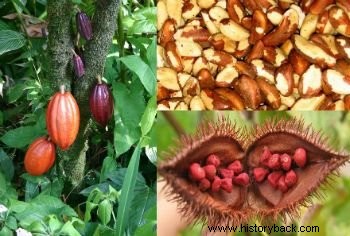The drugs of the sertão bring together the different types of spices (plants, roots, seeds, fruits, medicinal herbs, etc.) that were commercialized in Colonial Brazil (northeastern sertão) from the 16th and 17th centuries. Some scholars refer to this moment as the “Sertão Drug Cycle”.
These products were grown in Brazilian territory and sold on European soil since they were exotic, native to Brazil and highly coveted by the foreign market. They were considered by Europeans as “new spices”.
 Cocoa, Brazil nuts and Annatto
Cocoa, Brazil nuts and Annatto
This factor of great interest made the Portuguese Crown elect the Jesuit missions to control the exploitation of these products.
Historical Context
Drugs from the sertão began to be cultivated and presented high economic value during the period of the “Entradas e Bandeiras”, pioneering expeditions with strategic and economic purposes, which were responsible for the conquest and expansion of the Brazilian territory.
The bandeirantes (or sertanistas) were responsible for the conquest and searched for precious metals and stones in the colony, in order to enrich the foreign consumer market.
It was from then on that the so-called “drugs of the sertão” started to have a very important economic character, favoring the occupation of the north and northeast region of the country. Thus, after the exploitation of pau-brasil, sugarcane became one of the most important products alongside drugs in the sertão.
These spices (annatto, cocoa, guarana, cloves, cinnamon, chestnuts, pepper, vanilla, etc.) cultivated in northeastern Brazil were one of the main sources of income for the Portuguese Crown, which at the time, were looking for a way to enrich themselves.
Indigenous slave labor was used, given the knowledge they had about the various spices. Later, indigenous slavery was banned and replaced by slave labor from Africa.
Learn more about Indigenous Slavery in Colonial Brazil.
At that time, the Amazon region was heavily explored by the Portuguese and boosted by the invasion of some European peoples who were trying to conquer the territory and find other riches:French, English, Spanish and Dutch.
Faced with this, the Portuguese managed to expel the invading peoples and with a type of colonialism called "Exploration Colony" they focused on the search for profit and the expansion of the financial market.
Therefore, from the beginning of the 16th century, the Portuguese began several reconnaissance and exploration expeditions in the interior areas of the Amazon jungle.
In this context, the pioneer explorers emerged, who carried out several expeditions that aimed not only at the exploration of the territory, but also the search for fugitive slaves and the capture of indigenous people (whether to commercialize them, execute them or enslave them). ).
Thus, they invaded several territories of the Brazilian forest, establishing settlement centers. With the cultivation of sugar cane (sugar cane cycle) the exploitation of “drugs of the sertão” went into decline.
From the 17th century onwards, the focus of enrichment for the Portuguese was the planting of cane and the creation of sugar mills across the country. This period became known as the sugarcane cycle.
Expand your knowledge by reading the articles :
- Colonial Brazil
- Entries and Flags
- Bandeirantes
